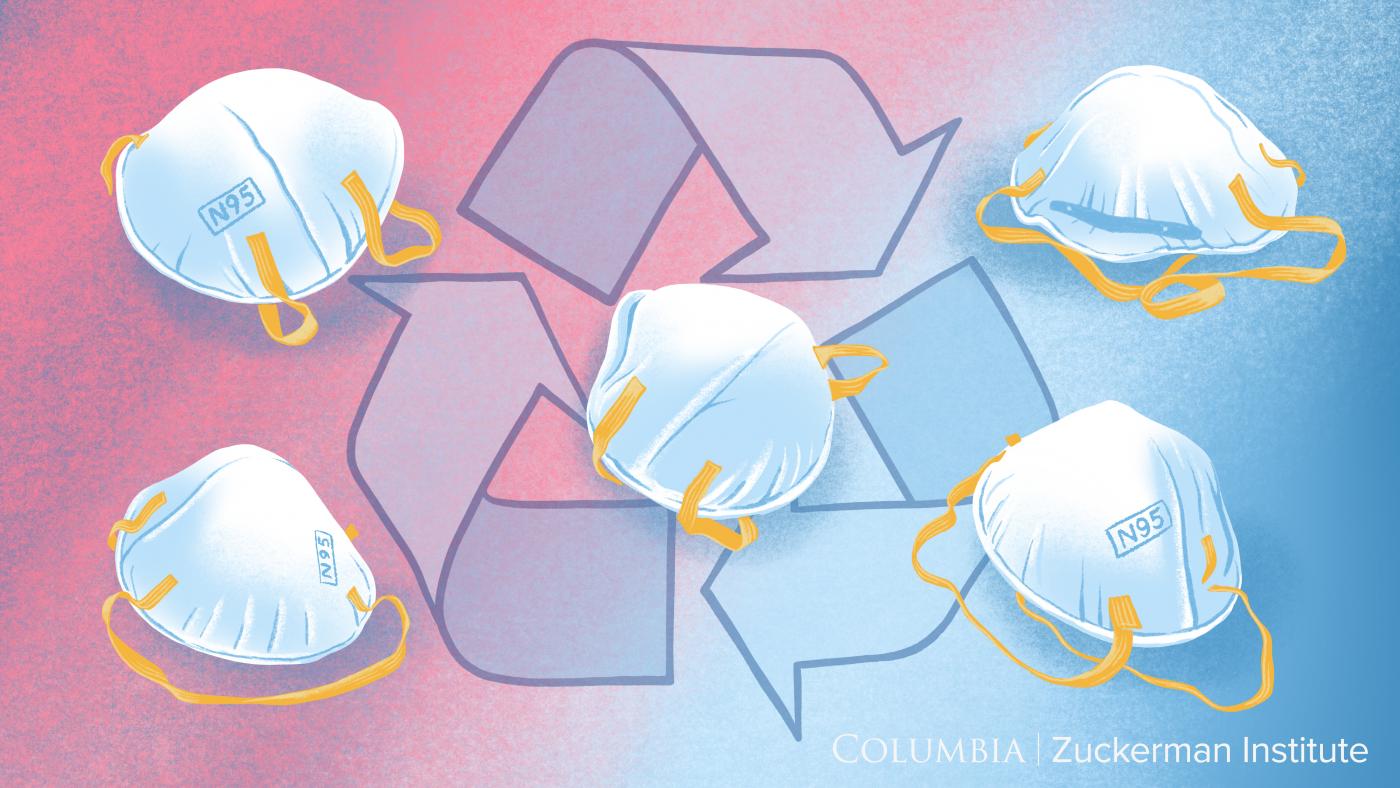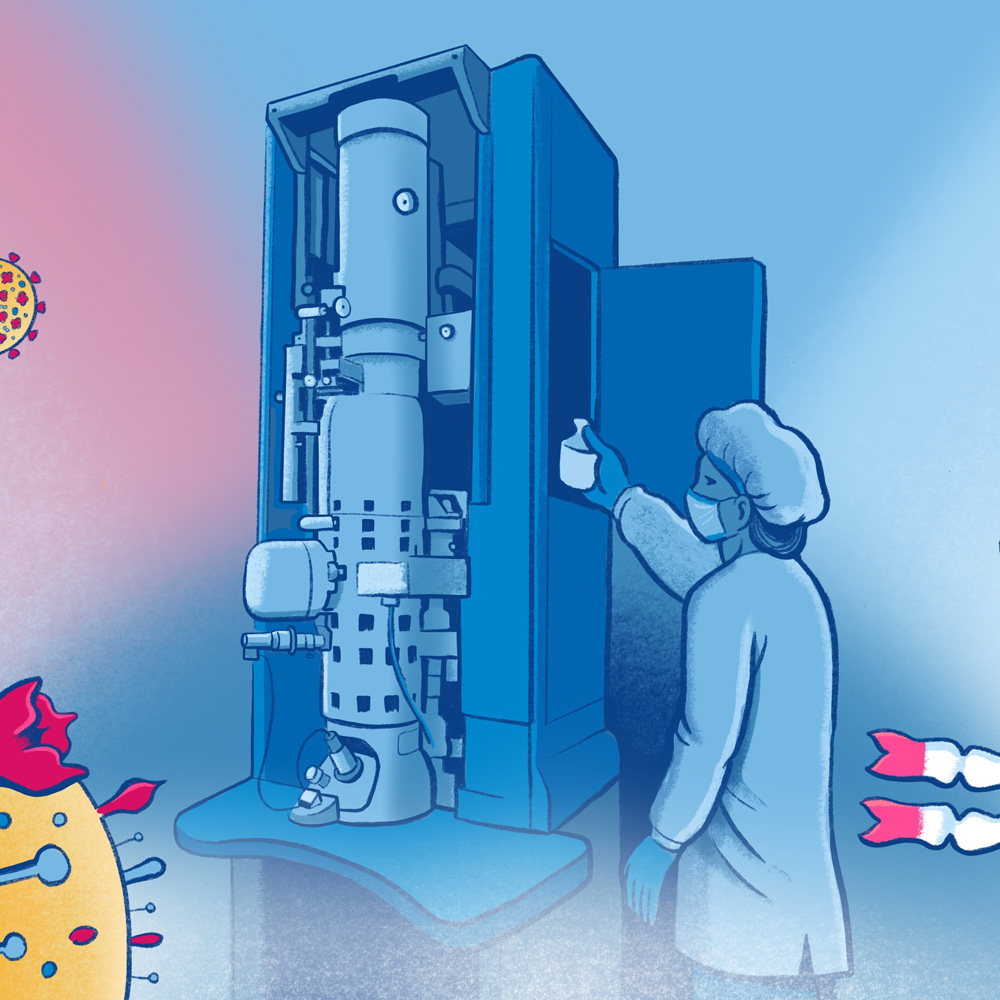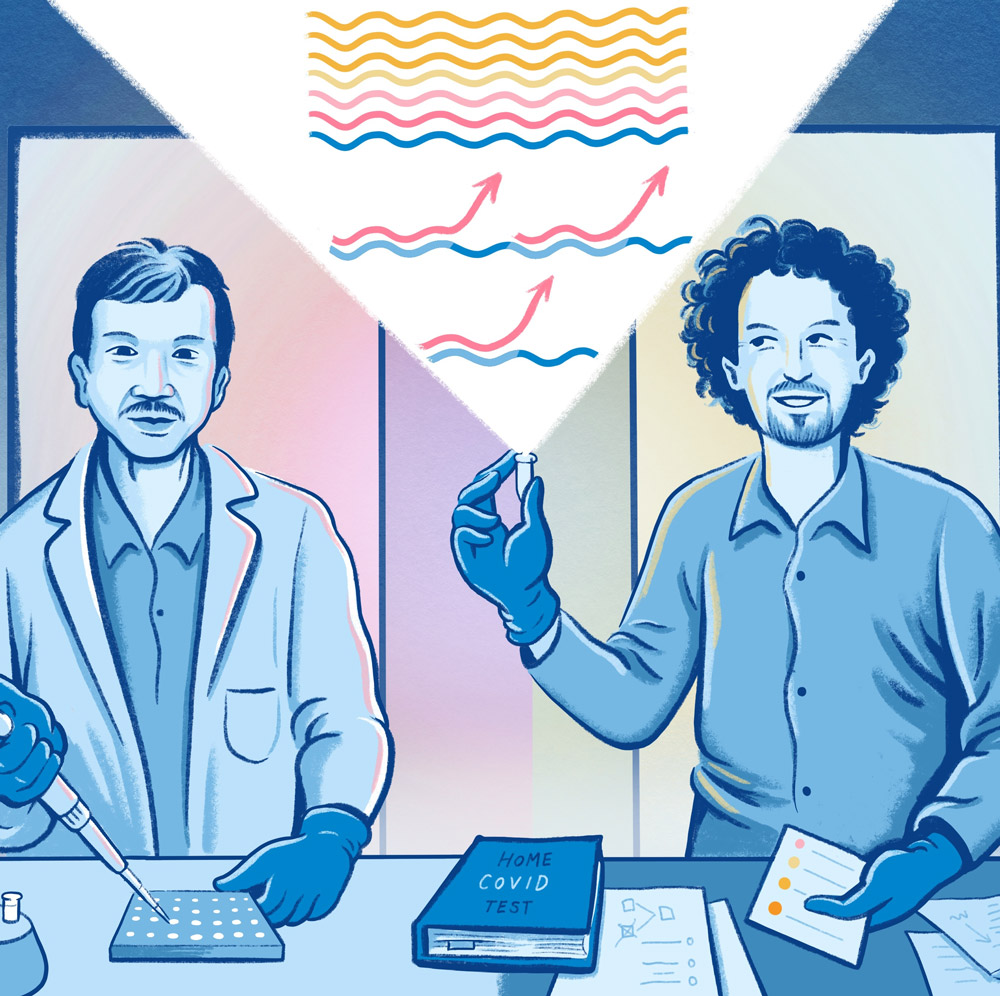KATHLEEN DURKIN I’m Kathleen Durkin, of Columbia University’s Zuckerman Institute.
DEVIN POWELL And I’m Devin Powell of the Zuckerman Institute.
KATHLEEN Welcome to Lab in the Time of Coronavirus, a podcast that looks at scientists pivoting their work to combat this pandemic.
DEVIN Let’s start today with a quick check in. So three months ago, the World Health Organization officially declared coronavirus a pandemic. In June, the number of worldwide cases reached a record high. Across the city, across the country, across the world, people have developed a new habit: wearing face masks. Kathleen, what kind of face mask do you wear?
KATHLEEN We have 50-pack of those disposable blue surgical masks and just grab a fresh one when we need it. How about you, Devin?
DEVIN My favorite is a homemade mask that my sister sewed for me. It’s covered with flowers.
KATHLEEN That sounds very fancy. But are we using masks correctly? How often do you change your mask or clean it? How are you supposed to clean it, anyway? Researchers at Columbia are combing the scientific literature and trying to figure out how to make N95 masks safe to reuse. They’re looking for a fast, effective and easy way to sterilize them. Let’s meet the team, starting with a Zuckerman Institute research technician who usually studies the brain.
TIFFANY CHEN My name is Tiffany Chen, and I’m a member of Rui Costa’s lab. Normally I work to understand what happens in the brain when we learn how to perform new skilled actions. This has implications for understanding the pathology behind movement disorders such as Parkinson’s disease and also compulsive behaviors. I actually work directly with Leslie Sibener, who talked about the 3D-print-farm project on the first episode of this podcast.
DEVIN After her lab ramped down, Tiffany learned about a new project focused on face masks. It was coordinated by Columbia Researchers Against COVID-19, which goes by the acronym CRAC. We talked about this group back in our third podcast episode.
TIFFANY I know from working in research labs how important correct PPE usage is. And when I saw this project description, I instantly thought of my parents, who would text me questions about whether or not they should be wearing masks, when to wear masks, and if there are even ways to clean their masks. I realized that the public guidance on PPE has not been very clear.
DEVIN Tiffany has seen people do some strange things to masks.
TIFFANY People literally cut up their masks to improve breathability by making a giant gaping hole in their mask, effectively bringing the level of protection down to zero.
ANA PESSOA PINHARANDA So what people do is they put their masks on their forehead, they rest it on their chin, and they just generally walk around with them.
KATHLEEN That’s postdoctoral research scientist Ana Pessoa Pinharanda. She works in the Andolfatto lab at Columbia’s biological sciences department, where she’s usually studying fruit fly genomics. Now she’s a project leader for the mask reutilization effort.
ANA And then there are people that take their mask down, touch a railing and then go and put their masks up again. People use their masks like they would put on and take off sunglasses. And it’s not really the same. Masks should always be on, even when they’re uncomfortable.
DEVIN One area where there’s been a lot of confusion, Tiffany said, is how to clean masks.
TIFFANY From the people that I’ve talked to and my friends and family members, they have these ideas in their mind of how they can sterilize their masks. They think things like putting their masks under the sun for a while might inactivate the virus. They have tried a bunch of different methods such as spraying alcohol, which is not really great for masks. So we wanted to go through a debunk all these ineffective ways of cleaning your masks, because it gives people a false sense of security, and we don’t want that to happen. Our goals for this project are to first validate and test methods of mask decontamination that can be performed safely at home, and we also want to interpret official guidelines and scientific literature to inform the general public on why PPE is important and how to use it safely. The members of our team started by reviewing the existing studies on different methods of mask decontamination
ANA So there are three main methods of mask decontamination: UV-C, hydrogen peroxide vapor and heat.
DEVIN Each of these approaches has its limitations, especially for people trying to sterilize masks in their homes.
KATHLEEN UV-C stands for ultraviolet type C. It’s a subtype of ultraviolet light that can inactivate viruses like COVID. But it’s hard to use at home because the light has to penetrate every part of the mask’s surface to be effective.
DEVIN And hydrogen peroxide, well that’s not the liquid antiseptic you have in your medicine cabinet at home. We’re talking about hydrogen peroxide as a gas, which can be very dangerous for home use.
KATHLEEN So that leaves heat, which seemed like a promising avenue for everyday people. Especially those who rely on masks at work and need to decontaminate those masks at home.
ANA There are people in New York and around the world that work in nursing homes, at Amazon, in taxis that have no way to decontaminate their masks. For those people we thought the best method for them to do it safely in their own home would be to use heat. There are experiments practically showing that the virus is inactive after being exposed to heat, which basically means that it can’t infect any new cells. But the exact steps and the exact temperature ranges — that’s not in the literature to the best of my knowledge.
KATHLEEN The team started looking for ways to heat up masks at home.
TIFFANY We set out to determine which everyday household appliances can be used reliably to generate and sustain the amount of heat needed to inactivate the virus. But at the same time, these appliances should not overheat and damage a mask in a way that significantly limits its efficacy and longevity. So through our experiments, we hope to see if and how household appliances can be used to decontaminate a mask and how many times a mask can be decontaminated without compromising its structural integrity and thus efficacy.
Our goals for this project are to first validate and test methods of mask decontamination that can be performed safely at home.
ANA So we looked around and we started listing appliances that a common househould would have. It was sort of a process of elimination. So a microwave can heat, but that can be quite dangerous because a mask has metal. A tumble dryer sort of works, but they don’t have specific temperature ranges so it would be difficult. The issue with a hairdryer is that we would have to develop some sort of contraption where the mask would be inside a bag, because if you’re just blowing heat on a mask, you could just be spreading viral particles. So then we thought about a regular oven. But the issue with a regular oven is that most ovens don’t get to low enough temperatures that the mask would withstand.
KATHLEEN The researchers settled on a few kitchen appliances.
TIFFANY So we will be subjecting N95 masks to multiple rounds of decontamination and then fit testing them with the help of Columbia Environmental Health and Safety. Once we submit our experimental findings for peer review, we plan to launch a website and public health campaign for how people can best use and care for their PPE.
ANA We’re just focusing on N95s because N95s are very regulated. So any advice that we give from the literature we know that applies to all N95s. Cloth masks and surgical masks are less well regulated, so it would be harder to release advice on how to decontaminate them that would apply to all of them.
DEVIN Tiffany, Ana and the rest of the team are not ready just yet to make any recommendations for how to decontaminate masks. The science is still being done. They’re waiting for the results. That’s how science works. But Tiffany does have one solid piece of guidance for all of you mask wearers out there.
TIFFANY One of the main messages missing from the current narrative is the importance of fit. So a lot of people assume that just by owning an N95 or surgical mask they are automatically protected just by putting it on their face. But that’s not true. A mask works because you are breathing air in and out through the fabric, so the air is actually traveling through the fibers of the mask and thus being filtered. The mask needs to fit your face in order for effective filtration to occur. If the air is not traveling through the mask then you’re effectively not filtering the air. So that mask becomes ineffective. There have been studies that have shown that the filtration efficiency can drop up to 80 percent, just by having gaps in your mask. For example, one study showed that an N95 masks can go from having a 99.9 percent filtration efficiency to only about 12.2 percent filtration efficiency, which is extremely low and offers little protection. So we recommend that you test the fit of your mask and make sure that there are no air gaps and significant leakages, in order for the mask to be effective.
KATHLEEN Thanks for listening to Lab in the Time of Coronavirus. Take a look at the show notes for links to all of the things we discussed, including links to relevant scientific papers. You can find all of our episodes at zuckermaninstitute.columbia.edu or on iTunes. Take a moment to rate and review us on iTunes. That makes it easier for other people to find us.
DEVIN Special thanks to Rui Costa, Jennifer Farris, Elizabeth Hillman, the researchers who sat down with us for this episode, and the entire Zuckerman team. The music was provided, as usual, by Miguel Zenón, Jazz Artist-in-Residence at the Zuckerman Institute. If you have any thought or any questions, you can find us on Twitter and Instagram @ZuckermanBrain. But before we go, Kathleen I think you had one last question for our researchers today.
KATHLEEN What is the first thing you plan to do post-pandemic?
TIFFANY I would actually like to meet the people I’ve been working with on this project, face-to-face. It’s pretty incredible how close we’ve all gotten without even meeting in person.
ANA I’d love to go out and dance. To be in a big club with lots of people, spilling drinks. I want to be in a sweaty New York club with lots of people.



